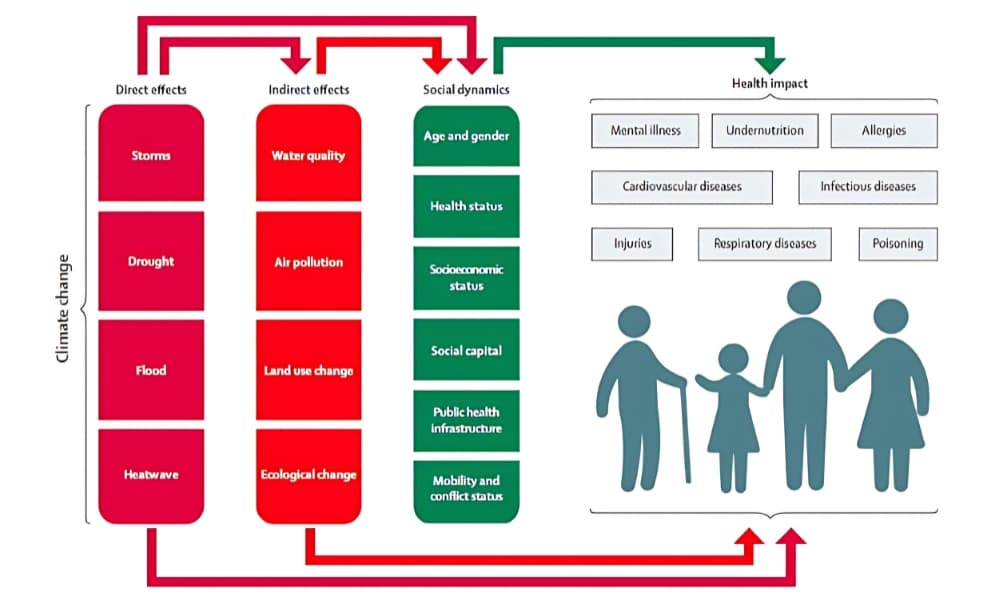Climate change and health are inextricably linked, posing significant and growing threats to the well-being of Australians. The changing climate, driven by human activities, is already manifesting in more frequent and intense extreme weather events, altered disease patterns, and increased risks to food and water security. Understanding the health impacts of climate change and implementing effective strategies to mitigate its health effects are crucial for safeguarding the health of current and future generations in Australia.

Since national records began in 1910, Australia’s climate has warmed by an average of 1.44 ± 0.24 °C. This warming trend is contributing to various health challenges across the continent. The State of the Climate 2024 report highlights that Australia is experiencing harsher fire seasons, more frequent ocean heatwaves, and sea-level rise. These environmental shifts have direct and indirect consequences for human health.
On this page
Direct health impacts of climate change
The most immediate health impacts of climate change arise from extreme weather events.
- Heatwaves: These are becoming more frequent, intense, and longer in duration. Between 2000 and 2019, an estimated 2,296 deaths per year in Australia were attributed to heat-related temperatures. Heatwaves exacerbate health conditions, particularly cardiovascular and respiratory illnesses, and can lead to heatstroke, dehydration, and kidney failure. Vulnerable populations, including the elderly, young children, outdoor workers, and those with pre-existing conditions, are at higher risk. In the summer of 2018-2019, Australia experienced a prolonged heatwave, with Adelaide recording a record-breaking 46.6 °C in January 2019.
- Bushfires: Increased temperatures and drier conditions contribute to more frequent and intense bushfires. Direct health impacts include burns, injuries, smoke inhalation, and mental health issues. Bushfire smoke contains delicate particulate matter (PM2.5), which can penetrate deep into the lungs, exacerbating respiratory and cardiovascular conditions. The “Black Summer” bushfires of 2019-2020 had devastating health consequences across eastern Australia.
- Floods and storms: Extreme rainfall events and storms are becoming more intense, leading to flooding, injuries, displacement, and an increased risk of waterborne diseases due to contaminated water supplies. Damage to infrastructure can disrupt healthcare services and access to essential resources. Queensland and New South Wales have been particularly affected by the increasing frequency of flood events.
- Droughts: Prolonged periods of low rainfall can lead to water scarcity, affecting hygiene and sanitation, and increasing the risk of certain infectious diseases. Droughts can also significantly impact agricultural productivity, leading to food insecurity and malnutrition, particularly in rural and remote areas. Mental health impacts, such as anxiety and depression, are also associated with drought conditions affecting livelihoods.
Did you know Energy Matters is Australia’s largest renewable news, blog and educational resource? Subscribe to Energy Matters’ weekly newsletter and keep updated even with incentives, rebates and recommended solar product offers.
Indirect health impacts of climate change
Beyond the direct impacts of extreme weather, climate change and health are linked through a range of indirect pathways.
- Vector-borne diseases: Changes in temperature and rainfall patterns can alter the distribution and life cycle of disease vectors, such as mosquitoes and ticks. This can lead to the emergence or re-emergence of vector-borne diseases, such as dengue fever, Ross River virus, and potentially malaria, in certain regions. Warmer temperatures can accelerate the growth of viruses in mosquitoes and expand the geographical areas suitable for vector populations.
- Food security: Climate change impacts agricultural yields through changes in temperature, rainfall, and increased frequency of extreme events. This can lead to reduced food production, increased prices, and decreased nutritional quality, affecting food security, particularly for vulnerable populations.
- Water quality and availability: Changes in rainfall patterns, increased temperatures, and more frequent droughts can affect the quality and availability of freshwater resources. Reduced river flows can concentrate pollutants, and increased temperatures can promote the growth of harmful algal blooms in waterways, posing risks to human health.
- Mental health: The experience of extreme weather events, displacement, loss of livelihoods, and the ongoing threat of climate change can significantly impact mental health and well-being. Increased rates of anxiety, depression, post-traumatic stress disorder, and a sense of eco-anxiety are being observed in communities affected by climate change. Rural communities that are dependent on agriculture and young people are particularly vulnerable.
- Air quality: In addition to bushfire smoke, climate change can worsen air quality through increased formation of ground-level ozone in warmer conditions and changes in pollen seasons, exacerbating respiratory illnesses like asthma and allergies.

Vulnerable populations and health inequities
The health impacts of climate change are not evenly distributed across the population. Certain groups are disproportionately vulnerable:
- Aboriginal and Torres Strait Islander peoples: Indigenous communities often live in remote areas, are more susceptible to extreme weather events and may have limited access to healthcare and resources. Their strong connection to land and culture makes them vulnerable to environmental changes.
- Low socio-economic groups: These communities often have limited resources to adapt to the impacts of climate change, such as affording air conditioning during heatwaves or relocating after floods. They may also have poorer baseline health, making them more susceptible to climate-related illnesses.
- Elderly: Older adults often have pre-existing health conditions and reduced physiological capacity to cope with extreme heat.
- Children: Infants and young children are more vulnerable to heat stress and the health impacts of air pollution.
- People with pre-existing health conditions: Individuals with cardiovascular, respiratory, and mental health conditions are at higher risk of exacerbations due to climate change impacts.
- Outdoor workers: Those working outdoors are at increased risk of heatstroke and exposure to extreme weather events.
- Rural and geographically isolated communities: These communities may face challenges accessing healthcare and emergency services during extreme weather events.
Mitigating climate health effects in Australia
Mitigating climate health effects requires a two-pronged approach: reducing greenhouse gas emissions to limit the extent of future climate change and implementing adaptation strategies to build resilience to the changes already occurring and those that are unavoidable.
Reducing greenhouse gas emissions
The most fundamental way to mitigate climate health effects is to reduce Australia’s contribution to global greenhouse gas emissions. This involves transitioning from fossil fuels towards renewable energy sources, improving energy efficiency, and reducing emissions from other sectors such as agriculture and transport.
- Renewable energy transition: Australia has made progress in increasing the share of renewable energy in its electricity mix. In 2024, renewable energy is expected to average around 40% in the National Electricity Market (NEM), up from 30.5% in 2021. The government aims for 82% renewable electricity by 2030. Continued investment in and deployment of solar, wind, and other renewable technologies are crucial.
- Emissions reduction targets and policies: Australia aims to reduce emissions by 43% below 2005 levels by 2030 and achieve net-zero emissions by 2050. Policies such as the Safeguard Mechanism, the legislated New Vehicle Efficiency Standard, and Renewable Energy Transformation Agreements with states and territories are steps in this direction. In 2024, Australia’s emissions decreased by an estimated 2.9 million tonnes of carbon dioxide equivalent.
- Sustainable transport: Encouraging active transport (walking and cycling), investing in public transport, and transitioning to electric vehicles can reduce transport-related emissions and improve air quality, leading to significant health co-benefits.
- Sustainable agriculture and land management: It is essential to implement practices that reduce agricultural emissions, including improved livestock management, soil carbon sequestration, and prevention of deforestation.
Adaptation strategies for the health sector
Building a climate-resilient health system is crucial for mitigating the health impacts of climate change. This involves a range of adaptation strategies:
- Heatwave management plans: Implementing and strengthening heatwave early warning systems, public awareness campaigns, and providing access to cooling centres for vulnerable individuals.
- Bushfire preparedness and response: Enhancing public health preparedness for bushfire events, monitoring air quality, providing respiratory protection, and ensuring adequate healthcare capacity.
- Flood and storm preparedness: Developing plans to maintain healthcare services during and after extreme rainfall, ensuring access to clean water and sanitation, and controlling waterborne disease outbreaks.
- Vector-borne disease surveillance and control: Strengthening surveillance systems to detect and respond to changes in vector populations and disease incidence, and implementing public health measures to prevent transmission.
- Mental health support: Increasing access to mental health services for individuals and communities affected by climate change-related events and the ongoing threat of climate change.
- Strengthening healthcare infrastructure: Ensuring healthcare facilities are resilient to extreme weather events, including maintaining power supply and access during emergencies.
- Workforce training and education: Equipping healthcare professionals with the knowledge and skills to address the health impacts of climate change.
- National health and climate strategy: Australia launched its first National Health and Climate Strategy in December 2023. This strategy outlines priorities for the next five years to build healthy, climate-resilient communities and a sustainable, net-zero health system. The plan focuses on health system resilience, decarbonisation, international collaboration, and a “Health in All Policies” approach.
Community and individual actions
Beyond government and health sector responses, actions at the community and individual levels are also crucial for mitigating climate health effects.
- Reducing energy consumption: Conserving energy at home and in transportation reduces greenhouse gas emissions and can improve air quality.
- Sustainable choices: Making sustainable consumer choices, such as reducing meat consumption, buying local and seasonal food, and reducing waste, can contribute to broader emissions reductions.
- Community resilience building: Participating in local initiatives to prepare for and respond to climate-related hazards can enhance community resilience.
- Advocacy and awareness: Raising awareness about the links between climate change and health and advocating for more decisive climate action can contribute to systemic change.
Sources: CSIRO – State of the Climate 2024: Australia is enduring harsher fire seasons, more ocean heatwaves and sea-level rise | Better Health Channel – Climate change and health | NSW Health – Climate change and health | Australian Government Department of Health and Aged Care: Climate change, National Health and Climate Strategy | ScienceDirect – Preventing and mitigating health risks of climate change
Energy Matters – Act now for a healthier future!
The evidence is clear: climate change and health are inextricably linked, and Australians are already experiencing the detrimental health impacts of climate change. From more intense heatwaves and bushfires to the spread of vector-borne diseases and increased mental health burdens, the threats are significant and growing.
Mitigating climate health effects requires urgent and comprehensive action on multiple fronts. We must accelerate the transition to clean energy, implement robust adaptation strategies within our health systems and communities, and empower individuals to make sustainable choices.
The time to act is now. Let’s embrace a future powered by clean energy and build a healthier, more resilient Australia for all. Energy matters, and so does our health – choose action today!
Energy Matters has been recognised for our continued excellence in the Australian solar industry. We provide our customers with high-quality resources, insight, and access to reputable solar quotes.
Our team of solar experts can help you get up to 3 FREE solar quotes from pre-qualified and vetted solar firms in your area.















































